Identifying Boletus Mushrooms
30th July 2015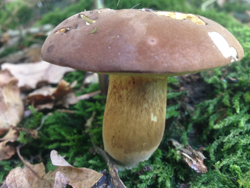 A common and easy to identify family of mushrooms, the Boletus family is a large genus of mushrooms which until recently was split into a few smaller families, the main three being; Boletus, Leccinum, and Suillus. With the genome of mushrooms now being sequenced the family has been split much more with the scientific names changing regularly, this can lead to confusion with identification so for the purposes of foraging we consider any mushroom with a stem and pores instead of gills a Bolete.
A common and easy to identify family of mushrooms, the Boletus family is a large genus of mushrooms which until recently was split into a few smaller families, the main three being; Boletus, Leccinum, and Suillus. With the genome of mushrooms now being sequenced the family has been split much more with the scientific names changing regularly, this can lead to confusion with identification so for the purposes of foraging we consider any mushroom with a stem and pores instead of gills a Bolete.
Almost all members of the larger Boletaceae family have pores or tubes instead of gills which make them an easy family to identify. Boletales also contain some mushrooms without tube-like pores like the Paxillus, Hygrophoropsis and Scleroderma families but this article is about Boletes with tube-like pores instead of gills or internal spores.
Boletes are usually large fleshy mushrooms that come in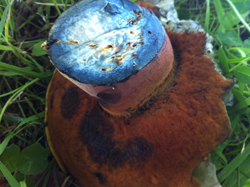 a variety of colours with a thick or bulbous stem and no ring, except for some of the Suillus. The stem often has a network of dark lines or spots. The pores under the cap can be white, cream, yellow, orange or red and are normally easy to remove from the cap.
a variety of colours with a thick or bulbous stem and no ring, except for some of the Suillus. The stem often has a network of dark lines or spots. The pores under the cap can be white, cream, yellow, orange or red and are normally easy to remove from the cap.
There are about two hundred and fifty Boletes worldwide with about eighty identified in the UK which, with only a handful to avoid due to toxicity, leaves a good amount of edible mushrooms that can be safely identified for consumption.
For the novice forager there are three rules of identification for edible Boletes that will keep you safe:
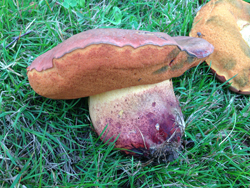 1. Make sure you have a Bolete, an upright mushroom with a stem and with sponge like pores instead of gills under the cap and growing in soil, not on wood.
1. Make sure you have a Bolete, an upright mushroom with a stem and with sponge like pores instead of gills under the cap and growing in soil, not on wood.
2. If there is any red colouring on the mushroom, that includes the stem, pores or cap, avoid as this can be the sign of a toxic Bolete.
3. Slice the mushroom in half vertically, if the flesh turns vivid blue quickly after or immediately on cutting, again avoid due to possible toxicity. The pores on a few edible Boletes can discolour to green or blue but it is the flesh changing colour rapidly that is a sign to avoid the mushroom.
Keeping to the above rules will keep you safe when foraging for Boletes; this does mean that you are missing out on some of the good edible ones but more importantly, avoiding the toxic mushrooms. 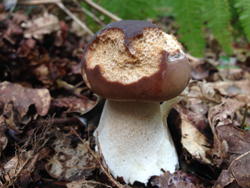 With a little experience you will get used to identifying this family and as it becomes easier to distinguish between them you will be able to safely identify some of the edibles that don’t stick to the above rules.
With a little experience you will get used to identifying this family and as it becomes easier to distinguish between them you will be able to safely identify some of the edibles that don’t stick to the above rules.
There is one mushroom that will pass the above rules of edibility that I don’t recommend eating; it’s not toxic in any way but will ruin any dish it gets into: the Bitter Bolete, Tylopilus felleus. It is one of the most bitter things I have ever tried, the bitter taste lasted for most of the day. It looks quite like the Penny Bun, Boletus edulis, but a small nibble of the mushroom will soon let you know if it is a Cep or Bitter Bolete or if you are a bit worried about nibbling unknown mushrooms the Cep’s stem has a white network of lines on a slightly darker background; the Bitter Bolete has a darker network of lines on a lighter background.
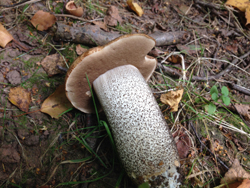 The Cep, Porcini, Penny Bun or King Bolete, Boletus edulis is considered one of the best edible mushrooms, hence the many names and high prices it commands but other Boletes like the Bay Bolete, Boletus badius, the Dark Bolete, Boletus aereus, or the Orange Birch Bolete, Leccinum versipelle, in my mind are every bit as good, just not as well known.
The Cep, Porcini, Penny Bun or King Bolete, Boletus edulis is considered one of the best edible mushrooms, hence the many names and high prices it commands but other Boletes like the Bay Bolete, Boletus badius, the Dark Bolete, Boletus aereus, or the Orange Birch Bolete, Leccinum versipelle, in my mind are every bit as good, just not as well known.
Leccinums generally have less bulbous, white/off-white stems that are covered in woolly black scales giving them a dirty appearance. The Orange Birch Bolete, Leccinum versipelle, is one of the most nutritious fungi growing in the UK with proteins, carbohydrates and fats at a higher level to most other mushrooms, they also contain many minerals and vitamin A and some of the B vitamins. Leccinums should all be well cooked before consumption, a minimum of ten minutes being the often quoted guideline.
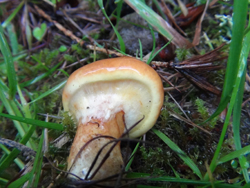 Suillus mainly have glutinous caps, some have rings on the stem and they all grow in association with conifers. One of the most common and easily identified Suillus is the Slippery Jack, Suillus luteus, it has a ring on the stem and a slimy cap. It is an okay edible mushroom once the slime has been removed but improves in flavour if the pores are also removed and the mushroom sliced and dried. Another very common Suillus is the Larch Bolete, Suillus grevillei, which is odd in that when young it has a white woolly veil or fine cobweb-like mesh covering the pores, a little like a Cortinarius (The Webcap Family of mushrooms). It is best to remove the slimy top and soft pores of Suillus mushrooms as they can cause minor gastric upsets in some people.
Suillus mainly have glutinous caps, some have rings on the stem and they all grow in association with conifers. One of the most common and easily identified Suillus is the Slippery Jack, Suillus luteus, it has a ring on the stem and a slimy cap. It is an okay edible mushroom once the slime has been removed but improves in flavour if the pores are also removed and the mushroom sliced and dried. Another very common Suillus is the Larch Bolete, Suillus grevillei, which is odd in that when young it has a white woolly veil or fine cobweb-like mesh covering the pores, a little like a Cortinarius (The Webcap Family of mushrooms). It is best to remove the slimy top and soft pores of Suillus mushrooms as they can cause minor gastric upsets in some people.
Nearly all members of the Boletaceae family have mycorrhizal relationships with trees and can be found under and around both broadleaf and coniferous trees with a few exceptions like the Parasitic Bolete, 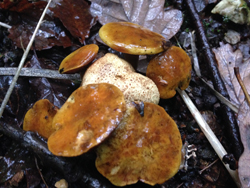 Boletus parasiticus, which grows from the Common Earth ball, Scleroderma citrinum, which makes this particular Bolete quite unique.
Boletus parasiticus, which grows from the Common Earth ball, Scleroderma citrinum, which makes this particular Bolete quite unique.
Some people remove the pores when they find Boletes and spread them about the surrounding area, this will leave behind some spores in the right environment to have a chance of growing into a new mushroom and I will do this with some of the Boletes I find as the pores can become slimy when cooked, but mushrooms like the Penny Bun or Dark Bolete are too good to throw any part of them away and I will eat these mushrooms pores, stem and any maggots included (within reason)!
Most of the Boletes are loved by maggots as well as us humans so I have learnt to share by leaving 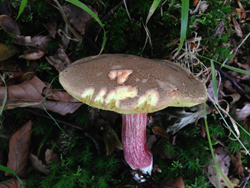 behind the really maggot-eaten mushrooms and ignoring the odd few maggots in good specimens, they were born in the mushroom and have only ever eaten mushroom, they taste of mushroom and I’m not prepared to leave behind all the mushrooms I find with maggots in as I would soon end up very hungry indeed. That said the Bay Bolete, Boletus badius, seems not to attract too many flies and can usually be found maggot free.
behind the really maggot-eaten mushrooms and ignoring the odd few maggots in good specimens, they were born in the mushroom and have only ever eaten mushroom, they taste of mushroom and I’m not prepared to leave behind all the mushrooms I find with maggots in as I would soon end up very hungry indeed. That said the Bay Bolete, Boletus badius, seems not to attract too many flies and can usually be found maggot free.





66 comments for Identifying Boletus Mushrooms
Hi. Why great description. But why must it be very well cooked if not toxic ?
Some mushrooms are toxic unless cooked, they will only cause gastric upset but who wants that.
All mushrooms, including the the common commercially cultivated spieces, can be mildly toxic/irritating if eaten raw in their wild form.
I’ve been finding a lot of boletes that I thought were cornflower boletes, but though they have cream tops and stain bright blue, they have distinctly pale yellow pores and stem, whereas cornflowers in pictures seem to be fairly uniformly cream.
Any idea what they are?
Probably Caloboletus radicans, rooting bolete, rather bitter!
Its not toxic when cooked, but it can cause problems when eaten raw
Hi, my Boletus turned a pale shade of greeny blue; is it safe to eat?
Without seeing the mushroom I couldn’t say but to stay 100% safe if you are not sure of the species avoid any with red markings or that stain blue when cut. You’ll miss out on some good edibles but also avoid the poisonous ones.
Hello. I am looking for someone to identify some boletus I ate after they had been dried. 24 hours later I vomited and have been feeling ill. I have photographs of the mushrooms. Please can you advise?
Sorry for the late reply, you can send in photos to [email protected] and we will try to identify the mushroom for you.
Reviewing my last comment and your remarks on boletus mushrooms I find that you DID mention the Bitter Bolete, Tylopilus felleus, sorry, I overlooked this. However my additional observations concerning the degree of pink colour of the pores or tubes of the undersides of the hat may come in useful to some happy frinders of good-looking specimens of Boleto. Better disappointed early than losing the complete meal which might have been so delicious.
Found some edible boleros in Charlotte, NC . June 28, 2020
I found a boletus mushroom where the flesh of the stem stained blue immediately upon cutting, whereas the flesh of the cap remained pale. When you say to avoid species who’s flesh turns blue, do you mean flesh of stem and cap?
If the flesh in the stem or cap turns blue immediately then avoid unless you know your Boletes well enough to make a positive ID.
I believe I have found bay bolete , turns blue instantly. I know they are classed as inedible. Is that because they make you hullucinate or because they would make you ill?
Some Boletes that turn blue are good edible mushrooms, the rule of avoiding them is for novice foragers to keep them completely safe and give them confidence before learning some of the individual Boletes. Any toxic Boletes will make you feel ill if consumed, especially if consumed raw. They have no hallucinogenic properties.
In a wood i frequent, i recently went a little off track and found literally hundreds of Boletes. They were all
well past their best with dirty grey caps with yellow undersides. They may even be from last year given their
condition.I was unable to properly identify them, but was surprised that at this time of year, there were no
fresh growing ones anywhere, as in places nearby i have found numerous Bay Boletes through late Summer
and Autumn.
Hi. I have found some brown bolotes with pale pink stems and yellow tubes. Also pink on cap where holes nibbled. Is pink ok, as opposed to red? When cut it turned very gradually pale blue/green over the course of about 30 mins. So not immediately. Thanks
Thanks for the link to Caloboletus radicans (September 8 2020). It was not in my mushroom books and I’d been puzzled about what it was. Mystery solved – white Boletus = not edible.
Hi,
Found some boletes yesterday with yellow pores which release dark brown spores, a dark brown cap which peels off to reveal plain white flesh underneath, and a plain white stem. When sliced vertically down the middle the flesh remains mostly white, but with some pink/red staining in the cap. The stems are thicker at the base.
Would you have any ideas what they might be?
Thanks!
A.
P.S. are there any UK boletes which can be fatal to eat?
I can try to ID it for you if you can send in photos of the cap, stem, pores and one cut in half to [email protected].
The most poisonous Bolete in the UK is the Satans Bolete but there are no reported deaths in the UK, it seems more likely to cause illness but one report from Europe attributes a death to this mushroom, it is more toxic raw.
I think I have found a Red Mouth Bolete, Boletus Subvelutipes. It has a red stem, bright orange tubes and stains a deep blue when cut. Is this a common bolete and I am guessing I shouldn’t eat it. It is however beautiful to look at.
Happy to send a photo if it would help ID
My partner and I picked some ceps and cooked them yesterday (definitely ceps, have picked them before – spongy pores, bulbous white stalk and lovely brown bun-like cap – No red or blue staining flesh).
My partner is fine but I have been nauseous for the past 24 hours.
I have two questions,
first is: how long should you cook ceps for? If you don’t cook them for long enough can they be toxic?
Second is: Does anyone know if brown-birch ceps are toxic? I have read mixed reviews.
Thanks
Penny Buns can be eaten raw so it doesn’t matter how long they are cooked for.
I have seen one report from the US where there was a reported reaction when eating one of the brown Leccinums and consuming alcohol but have not heard this in the UK.
Thanks for the good info on this page.
I have just harvested what I think are two types of birch bolete and a couple of bay boletes. Also an orange capped bolete that didn’t blacken on cooking but was very tasty! Dunno what it was but as it passed your tests I went for it.
Thanks again.
I’d be interested to know about methods of picking the boletes, as I see some people advocate twisting them out of the ground, and others say cut them. Thanks
There is controversy over the best method, it is said that picking them could harm the mycelium and leaving an open cut stem could be an easy way in for bacteria. Does anybody have any scientific answers.
Hi, I’m in Scotland in the cairngorms national park and went foraging, I picked what I assumed were the baby cèpes that I am used to in France but upon arrival home, one that had a broken cap was dark blue/black where it broke, in doubt I just threw them all away and washed everything thoroughly but for my peace of mind, do you think they were toxic?
I can’t be sure without seeing them but they sound like one of the Leccinums which can look like a Cep. Some of them have darkening flesh if exposed for a while. They don’t sound toxic but it always best to be cautious, foraging is not an extreme sport!
I found a porcini mushroom in the woods or at least I think it is. How do I tell before I eat it?
With Boletes, as long as there is no red on the mushroom and the flesh doesn’t turn blue when cut, it is edible. The Penny Bun has white pores, a dark brown cap and a thick whitish stem with a net like covering that is lighter than the stem.
I think I got a bilhete, from what I understood is the only one with pores instead of gills right, and this one didn’t turn blue straight away, but now gotten a bit darker after a few minutes so I was wondering whether that’s is normal? The pores have a darken colour as well, not like I’ve seen in videos or pictures so far
Some of the Boletes have flesh that darkens but does not turn blue, but we would need to see photos of the stem, pores, cap and any flesh colour changes to be able to identify a Bolete.
Hi, I have found lots of small bolete mushrooms today, most are about 4 cm across and have a firm brown cap that looks a bit similar to the cep, they have bright yellow stems, not fat. the stems have blue on them that appear when I cut them, it happens over a few minutes. the flesh isn’t turning blue when cut. there is one that has had an insect eating the top and the flesh there has turned red. I thought maybe they were butter bolete but now after looking n this site I don’t think they are. Has anyone any idea’s please?
What is your definition of “toxic”, for the Boletes?
Gastric upset, seriously ill, death?
Thanks Steve
In the UK the toxic Boletes can cause gastric upsets although I’m not sure of the severity of these upsets.
How fresh must a bolete be before it is considered unsafe? In damp weather they all seem to have slimy wet caps. The sponge underneath changes from white/cream through yellowy to green then almost black. Are green stages still edible? If not why not? Can you remove the sponge and still eat the cap if not riddled with maggot holes?
Mushrooms are edible until they start to smell off or look off. It is safe to eat the pores but I tend to get rid of them if they are soft as they will go slimy in the pan. If it is a Penny Bun, I have a higher tolerance for maggots as it such a great tasting mushroom.
I live in new jersey, usa. Boletes recently started popping up, they are about a month late, crazy. My father and I brought back 106 today, 84 yesterday and 90somethingnlast week. A mix of slippery jacks, 2 toned, suede, brown birch, ghost, edulis (the basic orange/reddish/pinkish ones), as well as the cracked variety. On top of that we had milk caps and yellow and grey knights (yes I’m aware of the dangers… But I’m from a polish background.) I love picking em and finding new spots more than eating sometimes
How could I distinguish between Boletus, Xerocomos, Chalciporous, Suillus ?
Geoffrey Kibby has a great book about Boletes which includes all the UK boletes.
I found I believe is a boletes here in northern NM in the sandia mountains (Santa fe forest) and they’re all white. They have a little tan to the cap. When I cut them open still white. The stem if very fat and round. And the spores at the bottom were white. And it’s all sponge, no gills.
It sounds like a Bolete but without seeing it I couldn’t tell you if it is edible. We have a good rule for determining the edibility of British Boletes but as you are in NM I wouldn’t risk it.
Finding this page very helpful. I’m picking in Iceland and the tips are great. (I have local advice too of course) Thank you!
We have a lot of Leccinum scabrum. And also Penny Bun. Plus many other bolete, luckily not dense in the poisonous bolete here ☺️
I have found a type of Bolete that stains skin yellow, a slug has munched a bit and the flesh has stained red has a brown cap doesn’t look great is very soft any idea what ID this is, found iin soil in a beech wood
If you can send photos of the cap, pores, stem and flesh to [email protected] we’ll try to ID it for you.
we have an abundance of what we think are Slate Boletus under our 4 Poplar trees. we have eaten them raw and cooked and can confirm they are delicious. would love to know for sure that they are Slates or Penny buns /Porcinis etc. how could we tell? thank you . we have them in almost constant supply since May this year and we can almost watch them grow overnight at the moment it is incredible!
The Slate Bolete like to grow with Poplars and has a stem covered in black ‘scales’ or spots on a white background, the Penny Bun has a white stem with an off-white, mesh like covering called reticulation and can grow with a few different tree species. Our mycologist really likes the taste of the Slate Bolete, I haven’t found any yet.
so I found a brown capped, yellow pore mushroom with light brown netting and cream colored flesh. There were a few maggots but they were tiny. I thought I had a positive ID but when I was cooking it, I saw 2 pieces had turned a light blue. I’m curious if this is a reaction to the olive oil or leeks or if this is a sign that I had a false king bolete and not a butter foot bolete.
I’ve not heard of the False King Bolete but the Butter Bolete, Butyriboletus appendiculatus, can have blueing flesh.
Hello, I believe I have found some botletus edulis in the beech woods near me northeast UK but some of the stems are really large compared to the cap and someone told me it is infected with hypomyces chrysospermus… does this render it not edible? The mushrooms are in exceptional condition it’s just that some of the stems are large and bulbous compared to the cap. Thank you very much for this informative article and your time 🙏💗
Hi, Jennifer,
Yes, in this country (or in any other countries in Europe), any Hypomyces-infected bolete considered inedible.
Can someone tell me what the first picture in the collum is please
It is a Bay Bolete, Imleria badius.
We found some very young ones and the tops weren’t slimy at all. In an area known for slippery jacks though and we have seen big slippery jacks there. Can they be non-slimy when very young?
Thanks for your insight, very informative page!
They can be non-slimy in very dry conditions but they could easily have been a different Bolete.
i have a yard full of boletes that resemble pseudosensibilus , but they do NOT stain blue . i cant find a list of boletes that DO NOT stain blue ! any help ??
We don’t have pseudosensibilus in the UK so I can’t be of help I’m afraid.
when you say red, does reddish brown count, or like bright red? painted bolets are edible, I think, but they are definately red.
We mean red not really reddish brown but it is possible for the red to fade or discolour so you must decide if the mushroom is in good, fresh condition to be sure of colour. The rules for picking Boletes are meant for novice foragers to make things easier and safer when starting out. There are Boletes that have red on them and blueing flesh that are edible but these are for people more confident with mushroom ID. The most important rule is that if you are not 100% sure of your ID, don’t eat the mushroom.
Hi team,
Today I found a huge amount of boletes, under beech and hazel and in mixed woodland, on the edge so gets some light. Chalky UK downland. I have scoured Roger Phillips’ book (and yours), and John Wright’s and still can’t find what they are!
They are varying sizes, from 2cms cap to approx 8 cms, darkish tan rounded elegant cap that tips down when young, flattens out when mature, pale creamy yellow spores, long cream stem with brown vertical netting and ridges, that is slightly bulbous towards the base. Stained quickly blue/brown when cut (the stem), and then very dark brown. They smell nice and a bit like a Penny bun, and have no bitter taste, (taste mushroomy raw, with a tiny nibble) no redness to the stem. Cap is leathery/suede- like turning a little orange when slug damaged. Will do spore test tonight. I took a few but left the rest as wasn’t sure… I can send pics!
Yes, please send photos to [email protected] and we’ll do our best.
I gave bright yellow boletus with brown spores growing on the roots of a maple stump in northern Wi.
Any ideas?
We would need to see photos to have a chance at identifying a mushroom. You can send photos to [email protected] but we need photos of the stem, pores, cap and one cut in half to show any colour changes in the flesh, this is particularly important with Bolete ID. We can’t be certain with mushrooms that don’t grow in the UK but we’ll do our best.
A question on the boletes that need to be well cooked to destroy toxins, specifically the orange birch Bolete –
If you were to slice up and dry this mushroom, would it still need the thorough cooking after rehydrating with boiling water?
Thanks!
Josh
We recommend thoroughly cooking dried mushrooms like the Orange Birch Bolete or any other dried mushroom that must be cooked before consumption but this should happen naturally as dried mushrooms are generally used for soups and stews. If you were to boil the dried mushrooms for several minutes to rehydrate them, that would also be safe.